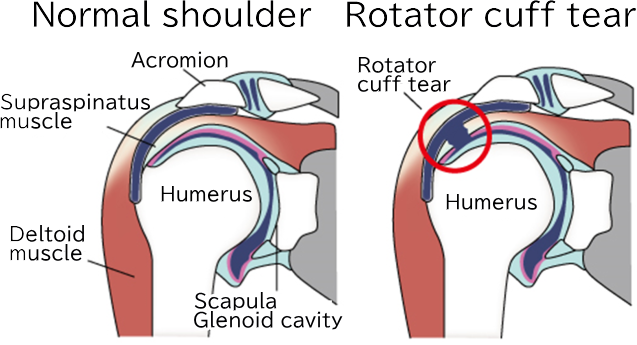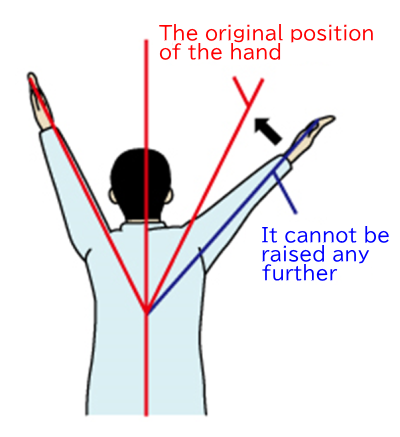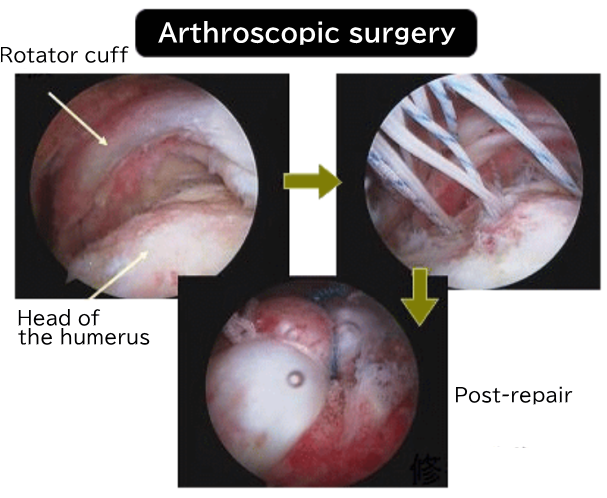Rotator cuff tear, Rotator cuff injury
What are rotator cuff tears and rotator cuff injuries
It is a rip in the group of muscles and tendons of the rotator cuff, tearing from the head of humerus.

Symptoms:

・Difficulty to raise the arm
・Distracted sleep with the pain, difficult to sleep on the injured shoulder side
・Aches when putting the arm down
・Unable to reach up high
・Unable to throw a ball
・Unable to open a sliding door (side movement)
Common symptoms of rotator cuff include dull ache, feeling of weakness when you lift or move your arm from the shoulder, or difficulty to raise the arm although you could normally raise.
What causes pain? Why can’t I raise the arm?
In rotator cuff injury, the injured muscles or tendons contact/rub the acromion or the ligaments and that restrict the shoulder joint motion. As the tear becomes bigger, the more it disturbs the tendons’ mechanisms to harmonize the shoulder movements, resulting in a loss of motion.
Treatment
Consultation and physical examination: Checking up shoulder motion
Medications and injections: Anti-inflammatory medications
Physical therapy: Ease the tension in tendons or muscles around the scapula, restore the range of motion
Surgery: Open surgery or Arthroscopic rotator cuff repair surgery is recommended in case the conservative treatments do not improve the condition.
As shown below, please also refer to the section on arthroscopic surgery.
The image above is a photo taken during the surgery using an arthroscope, and the surgical procedure is as follows:

① First, observe the interior of the shoulder joint with an endoscope to evaluate how to repair the rotator cuff.
② Insert screws with threads (called anchors) into the bone of the humerus.
③ Thread the rotator cuff using various instruments.
④ After threading the cuff, suture it and attach it to the bone.
Postoperative rehabilitation is crucial. Despite being arthroscopic surgery, there will initially be restrictions on the range of motion, and muscle tension needs to be addressed. Fixation with a brace is required for 3 to 4 weeks.
The hospital stay depends on consultation, but discharge with brace fixation is possible within approximately a week.
Recovery benchmarks indicate that daily life and light activities can resume 4 to 6 weeks post-surgery. However, there is individual variability, and heavy labor can only be performed after 4 months, as it takes 9 to 12 weeks for the tendons to attach to the bone.
The most important point is acknowledging individual differences in recovery. Patience and consistent rehabilitation are key.
Shoulder Diseases

We provide explanations for various shoulder conditions. Please use this as a general guide to determine which condition may apply to you.
- Common shoulder injuries by age group
- To those who neither have frozen shoulder nor rotator cuff tears
- Throwing Shoulder Disorder
- Rotator Cuff Tears and Rotator Cuff Injuries
- Recurrent Shoulder Dislocation
- Frozen Shoulder
- Shoulder Dislocation
- Acromioclavicular Joint Dislocation
- Chronic Acromioclavicular Joint Dislocation
- Frozen Shoulder
- Calcific Tendinitis of the Rotator Cuff
- Primary Degenerative Shoulder Arthritis
- Rotator Cuff Tear-related Degenerative Shoulder Arthritis
- Non-traumatic Shoulder Instability
- Biceps Tendon Injuries
- Surgical Trends for Throwing Shoulder in Baseball Players
